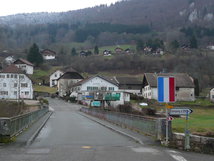Border: France-Switzerland
Overview
Heterogeneous territories
The current line of the French-Swiss border dates from the end of the Napoleonic wars, in the early 19th century. There is a high level of linguistic interpenetration between the areas on each side of the border, whether between Alsace and the German-speaking Swiss cantons on the northern part of the border or between the Franche-Comté and Rhône-Alpes regions and the French-speaking cantons on the central and southern parts. As the relief is mainly mountainous, cross-border relations are highly dependent on accessibility.
The southern part of the border, in the Alps, forms a specific territory as a consequence of geographical factors and the impetus of the cooperation initiated between France, Italy and Switzerland within the framework of the Espace Mont blanc.
On the central part of the border, the Jura Arc forms a cohesive cross-border area encompassing Bern, Vaud, Neuchâtel and Jura cantons and the Franche-Comté region (Doubs, Haute-Saône, Jura, Territoire de Belfort). Cross-border relations here are active and developing, despite a mountain range to cross and unfavourable climatic conditions. However, there has been little development of cross-border tourism in the area. Established in 1985, the Trans-Jura Conference (Conférence transjurassienne) is aiming to improve the development of exchanges within the area and to encourage cross-border communication between political and administrative institutions. The projects implemented in the cross-border territory, particularly in the Doubs department on the border, open the way to greater integration of the Jura Arc in cross-border cooperation. These projects include the French-Swiss Parc Naturel Régional (PNR) du Doubs and the Agglomération urbaine du Doubs.
Two major crossing points: the conurbations
Cross-border relations have developed at the two major crossing points on the French-Swiss border formed by the Rhine valley in the north and the Rhône valley in the south, occupied respectively by the Basel and Geneva cross-border conurbations. There is a degree of urban continuity between these two cities and the French territory bordering them. Saint-Louis, in Alsace, is the French suburb of Basel, and the Geneva urban area spreads uninterrupted towards France, encompassing the bordering territories in a spatial continuity covering the Pays de Gex, the Ain department, and the western part of the Haute-Savoie department, around Annemasse and Saint-Julien.
Within these two conurbations there are everyday exchanges in all areas of economic and social life (border workers, schoolchildren attending schools in the neighbouring country, reciprocal healthcare, commercial and cultural practices, etc.). Basel and Geneva are very attractive employment centres for French workers, because of the economic prosperity of Switzerland. Salaries there are on average twice as high as in France.
The imbalance in worker flows in these two conurbations (predominantly French residents working in Switzerland) is of course also driven by the lower cost of living in France than in Switzerland, in particular with regard to property, which encourages an increasing number of Swiss workers to take up residence in France while continuing to work in Switzerland.
Cross-border cooperation is advanced at the level of these two conurbations and affects many areas, including planning, urban development, employment, health, environment, education and economic development. In the case of Basel the cooperation is trinational, since German municipalities are also included in the cross-border conurbation.


